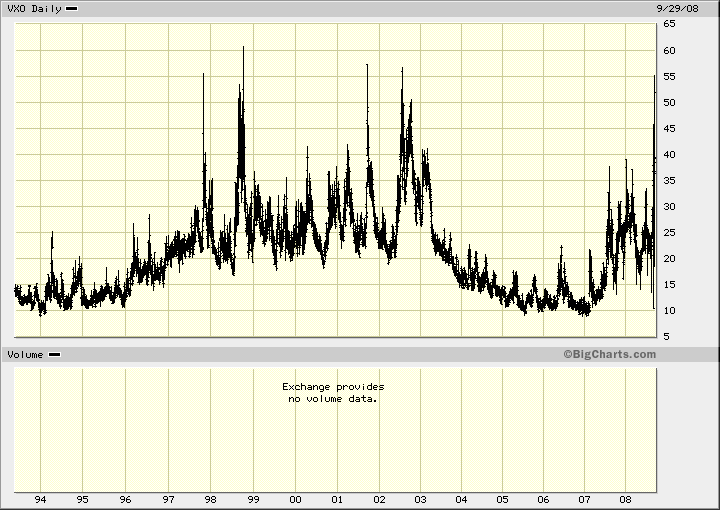Here’s another interesting and wonderful byproduct of our New World Order, the SKF is effectively non-operational.
Due to the emergency action announced by the Securities and Exchange Commission on September 18, 2008, temporarily prohibiting short sales of shares of certain financial companies, Short Financials ProShares (SEF) and UltraShort Financials ProShares (SKF) are not expected to accept orders from Authorized Participants to create shares until further notice. Unless notified otherwise, shares will be available for redemption by Authorized Participants as normal. The shares of these ProShares are expected to trade in the financial markets today, but may trade at prices that are not in line with their intraday indicative values.
So in other words, sounds like you can’t create “new” shares. John Gabriel of Morningstar has a great rundown of the situation here (hat tip Trader Mike).
The nickel version is that Pro-Shares does not short the component stocks themselves, they do swaps with third parties (sounds like something from some swingers in the 70’s, lol). But those 3rd parties can’t short anything now, so ProShares has to either just take on an unhedgable risk themselves or change their prospectus so that they can short stocks themselves AND get legal permission. So for now, it’s frozen. Frozen meaning no new shares can be created. If you own shares though you can still redeem them for NAV.
But no reason to do that, all this caused SKF to trade at a 5% or so premium to it’s NAV on Friday. So you’re better off selling than redeeming.
So going forward, does this present an opportunity? Well, I strongly doubt you can short the stock here, but what about taking a short delta in options? I mean SKF is overpriced, right?
Well, what can you do against it? You can’t short any component stocks unless you want Ben and Hank taking over your biz.
What about shorting XLF or UYG?
Now we’re talking. But here’s the rub. IF you can short SKF near where it’s actually trading somehow, and IF you can short XLF or UYG near where they’re trading at a given time, you will eventually make money if the SKF is this far above NAV. You’ll really make money if they resolve this in the next couple days. BUT I suspect the risk of such a play is ginormous. Why is a 5% premium in SKF a magical number, maybe it goes to 10% or 15%, who really knows? Remember first of all none of these pesky issues were accounted for when they banned shorting to begin with, what confidence should we have they’ll figure out how to unfreeze this thing any time soon? If that’s even something desirable to them. The Powers That Be may just as leave let this remain unresolved.
And remember also, SKF resets every day. It aspires to move twice the inverse percent of the IYF in one given day, nothing beyond that. So *errors* may compound each day until they figure it out.
Bottom line is if you’re running pretend capital and can double everything down and can figure out a way to short both sides every day, you’ll eventually win. But you may get incredibly incredibly squeezed in the meantime. Very similar to playing a stock merger arb where one side is a discount that will *probably* resolve. Tough to price *probably*.
There are going to be myriad odd opportunities going forward as the price of everything adjusts to a world where you can’t short the financias. And then inevitably goes back to a world where you can. SKF is clearly going to provide one of those opportunities, it’s just a dice roll into the unknown to see how it pans out though, a roll I do not plan to take at this point.
……..And just an aside to show the lunacy of this Short Bulletin Board we’re going to see soon, these Third Parties that do the swaps with ProShares are going to show up on some list as a major short player in every financial. And I’ll bet we’ll also find they keep shorting more and more on the way down. Those Bastards! Whoever approved SKF and the other Inverses should be courtmarshalled.
Oh wait, it was the SEC, nevermind.
Comments »

